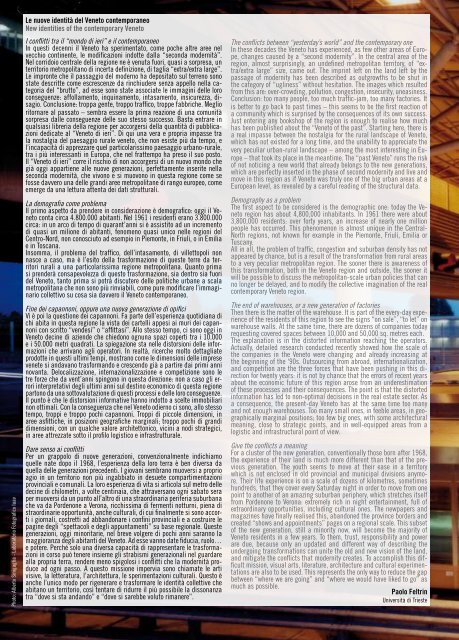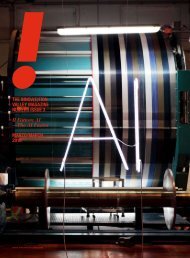PLEASE DISTURB - Fuori Biennale
PLEASE DISTURB - Fuori Biennale
PLEASE DISTURB - Fuori Biennale
You also want an ePaper? Increase the reach of your titles
YUMPU automatically turns print PDFs into web optimized ePapers that Google loves.
Photo: Alberto Sinigaglia - Laboratorio Fotografico Iuav<br />
le nuove identità del veneto contemporaneo<br />
new identities of the contemporary veneto<br />
I conflitti tra il “mondo di ieri” e il contemporaneo<br />
In questi decenni il Veneto ha sperimentato, come poche altre aree nel<br />
vecchio continente, le modificazioni indotte dalla “seconda modernità”.<br />
Nel corridoio centrale della regione ne è venuta fuori, quasi a sorpresa, un<br />
territorio metropolitano di incerta definizione, di taglia “extra/extra large”.<br />
Le impronte che il passaggio del moderno ha depositato sul terreno sono<br />
state descritte come escrescenze da rinchiudere senza appello nella categoria<br />
del “brutto”, ad esse sono state associate le immagini delle loro<br />
conseguenze: affollamento, inquinamento, intasamento, insicurezza, disagio.<br />
Conclusione: troppa gente, troppo traffico, troppe fabbriche. Meglio<br />
ritornare al passato – sembra essere la prima reazione di una comunità<br />
sorpresa dalle conseguenze delle suo stesso successo. Basta entrare in<br />
qualsiasi libreria della regione per accorgersi della quantità di pubblicazioni<br />
dedicate al “Veneto di ieri”. Di qui una vera e propria impasse tra<br />
la nostalgia del paesaggio rurale veneto, che non esiste più da tempo, e<br />
l’incapacità di apprezzare quel particolarissimo paesaggio urbano-rurale,<br />
tra i più interessanti in Europa, che nel frattempo ha preso il suo posto.<br />
Il “Veneto di ieri” corre il rischio di non accorgersi di un nuovo mondo che<br />
già oggi appartiene alle nuove generazioni, perfettamente inserite nella<br />
seconda modernità, che vivono e si muovono in questa regione come se<br />
fosse davvero una delle grandi aree metropolitane di rango europeo, come<br />
emerge da una lettura attenta dei dati strutturali.<br />
La demografia come problema<br />
Il primo aspetto da prendere in considerazione è demografico: oggi il Veneto<br />
conta circa 4.800.000 abitanti. Nel 1961 i residenti erano 3.800.000<br />
circa: in un arco di tempo di quarant’anni si è assistito ad un incremento<br />
di quasi un milione di abitanti, fenomeno quasi unico nelle regioni del<br />
Centro-Nord, non conosciuto ad esempio in Piemonte, in Friuli, o in Emilia<br />
e in Toscana.<br />
Insomma, il problema del traffico, dell’intasamento, di villettopoli non<br />
nasce a caso, ma è l’esito della trasformazione di queste terre da territori<br />
rurali a una particolarissima regione metropolitana. Quanto prima<br />
si prenderà consapevolezza di questo trasformazione, sia dentro sia fuori<br />
del Veneto, tanto prima si potrà discutere delle politiche urbane a scala<br />
metropolitana che non sono più rinviabili, come pure modificare l’immaginario<br />
collettivo su cosa sia davvero il Veneto contemporaneo.<br />
Fine dei capannoni, oppure una nuova generazione di opifici<br />
Vi è poi la questione dei capannoni. Fa parte dell’esperienza quotidiana di<br />
chi abita in questa regione la vista dei cartelli appesi ai muri dei capannoni<br />
con scritto “vendesi” o “affittasi”. Allo stesso tempo, ci sono oggi in<br />
Veneto decine di aziende che chiedono ognuna spazi coperti tra i 10.000<br />
e i 50.000 metri quadrati. La spiegazione sta nelle distorsioni delle informazioni<br />
che arrivano agli operatori. In realtà, ricerche molto dettagliate<br />
prodotte in questi ultimi tempi, mostrano come le dimensioni delle imprese<br />
venete si andavano trasformando e crescendo già a partire dai primi anni<br />
novanta. Delocalizzazione, internazionalizzazione e competizione sono le<br />
tre forze che da vent’anni spingono in questa direzione: non a caso gli errori<br />
interpretativi degli ultimi anni sul destino economico di questa regione<br />
partono da una sottovalutazione di questi processi e delle loro conseguenze.<br />
Il punto è che le distorsioni informative hanno indotto a scelte immobiliari<br />
non ottimali. Con la conseguenza che nel Veneto odierno ci sono, allo stesso<br />
tempo, troppi e troppo pochi capannoni. Troppi di piccole dimensioni, in<br />
aree asfittiche, in posizioni geografiche marginali; troppo pochi di grandi<br />
dimensioni, con un qualche valore architettonico, vicini a nodi strategici,<br />
in aree attrezzate sotto il profilo logistico e infrastrutturale.<br />
Dare senso ai conflitti<br />
Per un grappolo di nuove generazioni, convenzionalmente indichiamo<br />
quelle nate dopo il 1968, l’esperienza della loro terra è ben diversa da<br />
quella delle generazioni precedenti. I giovani sembrano muoversi a proprio<br />
agio in un territorio non più ingabbiato in desuete compartimentazioni<br />
provinciali e comunali. La loro esperienza di vita si articola sul metro delle<br />
decine di chilometri, a volte centinaia, che attraversano ogni sabato sera<br />
per muoversi da un punto all’altro di una straordinaria periferia suburbana<br />
che va da Pordenone a Verona, ricchissima di fermenti notturni, piena di<br />
straordinarie opportunità, anche culturali, di cui finalmente si sono accorti<br />
i giornali, costretti ad abbandonare i confini provinciali e a costruire le<br />
pagine degli “spettacoli e degli appuntamenti” su base regionale. Queste<br />
generazioni, oggi minoritarie, nel breve volgere di pochi anni saranno la<br />
maggioranza degli abitanti del Veneto. Ad esse vanno date fiducia, ruolo…<br />
e potere. Perché solo una diversa capacità di rappresentare le trasformazioni<br />
in corso può tenere insieme gli strabismi generazionali nel guardare<br />
alla propria terra, rendere meno spigolosi i conflitti che la modernità produce<br />
ad ogni passo. A questo missione impervia sono chiamate le arti<br />
visive, la letteratura, l’architettura, le sperimentazioni culturali. Questo è<br />
anche l’unico modo per rigenerare e trasformare le identità collettive che<br />
abitano un territorio, così tentare di ridurre il più possibile la dissonanza<br />
tra “dove si sta andando” e “dove si sarebbe voluto rimanere”.<br />
The conflicts between “yesterday’s world” and the contemporary one<br />
In these decades the Veneto has experienced, as few other areas of Europe,<br />
changes caused by a “second modernity”. In the central area of the<br />
region, almost surprisingly, an undefined metropolitan territory, of “extra/extra<br />
large” size, came out. The imprint left on the land left by the<br />
passage of modernity has been described as outgrowths to be shut in<br />
the category of “ugliness” without hesitation. The images which resulted<br />
from this are: over-crowding, pollution, congestion, insecurity, uneasiness.<br />
Conclusion: too many people, too much traffic-jam, too many factories. It<br />
is better to go back to past times – this seems to be the first reaction of<br />
a community which is surprised by the consequences of its own success.<br />
Just entering any bookshop of the region is enough to realise how much<br />
has been published about the “Veneto of the past”. Starting here, there is<br />
a real impasse between the nostalgia for the rural landscape of Veneto,<br />
which has not existed for a long time, and the unability to appreciate the<br />
very peculiar urban-rural landscape – among the most interesting in Europe<br />
– that took its place in the meantime. The “past Veneto” runs the risk<br />
of not noticing a new world that already belongs to the new generations,<br />
which are perfectly inserted in the phase of second modernity and live and<br />
move in this region as if Veneto was truly one of the big urban areas at a<br />
European level, as revealed by a careful reading of the structural data.<br />
Demography as a problem<br />
The first aspect to be considered is the demographic one: today the Veneto<br />
region has about 4,800,000 inhabitants. In 1961 there were about<br />
3,800,000 residents: over forty years, an increase of nearly one million<br />
people has occurred. This phenomenon is almost unique in the Central-<br />
North regions, not known for example in the Piemonte, Friuli, Emilia or<br />
Tuscany.<br />
All in all, the problem of traffic, congestion and suburban density has not<br />
appeared by chance, but is a result of the transformation from rural areas<br />
to a very peculiar metropolitan region. The sooner there is awareness of<br />
this transformation, both in the Veneto region and outside, the sooner it<br />
will be possible to discuss the metropolitan-scale urban policies that can<br />
no longer be delayed, and to modify the collective imagination of the real<br />
contemporary Veneto region.<br />
The end of warehouses, or a new generation of factories<br />
Then there is the matter of the warehouse. It is part of the every-day experience<br />
of the residents of this region to see the signs “on sale”, “to let” on<br />
warehouse walls. At the same time, there are dozens of companies today<br />
requesting covered spaces between 10,000 and 50,000 sq. metres each.<br />
The explanation is in the distorted information reaching the operators.<br />
Actually, detailed research conducted recently showed how the scale of<br />
the companies in the Veneto were changing and already increasing at<br />
the beginning of the ‘90s. Outsourcing from abroad, internationalization,<br />
and competition are the three forces that have been pushing in this direction<br />
for twenty years: it is not by chance that the errors of recent years<br />
about the economic future of this region arose from an underestimation<br />
of these processes and their consequences. The point is that the distorted<br />
information has led to non-optimal decisions in the real estate sector. As<br />
a consequence, the present-day Veneto has at the same time too many<br />
and not enough warehouses. Too many small ones, in feeble areas, in geographically<br />
marginal positions; too few big ones, with some architectural<br />
meaning, close to strategic points, and in well-equipped areas from a<br />
logistic and infrastructural point of view.<br />
Give the conflicts a meaning<br />
For a cluster of the new generation, conventionally those born after 1968,<br />
the experience of their land is much more different than that of the previous<br />
generation. The youth seems to move at their ease in a territory<br />
which is not enclosed in old provincial and municipal divisions anymore.<br />
Their life experience is on a scale of dozens of kilometres, sometimes<br />
hundreds, that they cover every Saturday night in order to move from one<br />
point to another of an amazing suburban periphery, which stretches itself<br />
from Pordenone to Verona: extremely rich in night entertainment, full of<br />
extraordinary opportunities, including cultural ones. The newpapers and<br />
magazines have finally realised this, abandoned the province borders and<br />
created “shows and appointments” pages on a regional scale. This subset<br />
of the new generation, still a minority now, will become the majority of<br />
Veneto residents in a few years. To them, trust, responsibility and power<br />
are due, because only an updated and different way of describing the<br />
undergoing transformations can unite the old and new vision of the land,<br />
and mitigate the conflicts that modernity creates. To accomplish this difficult<br />
mission, visual arts, literature, architecture and cultural experimentations<br />
are also to be used. This represents the only way to reduce the gap<br />
between “where we are going” and “where we would have liked to go” as<br />
much as possible.<br />
paolo feltrin<br />
Università di Trieste



